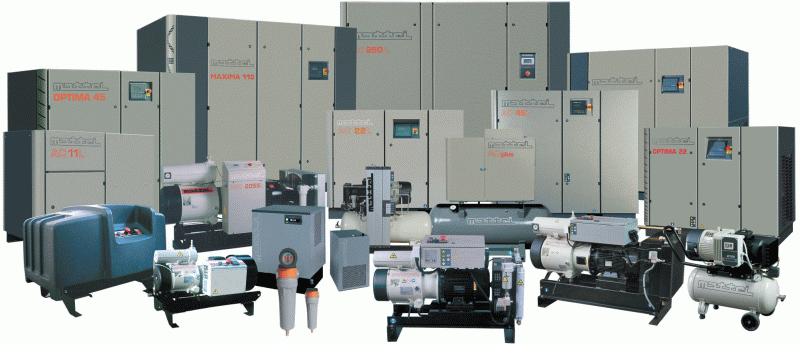 When purchasing new compressors an increasing number of factory managers are starting to include the term ‘oil-free’ and ‘class zero oil’ on their tender documents. Here Andy Jones, general manager of Mattei, examines this trend, and discusses what class zero really means, and how oil-free air can best be achieved
When purchasing new compressors an increasing number of factory managers are starting to include the term ‘oil-free’ and ‘class zero oil’ on their tender documents. Here Andy Jones, general manager of Mattei, examines this trend, and discusses what class zero really means, and how oil-free air can best be achieved
In recent years there has been a definite trend towards ‘oil-free’ and ‘class zero’ compressed air, with these terms increasingly finding their way onto tender documents.
Historically it was only the most sensitive of environments that required compressed air to have such a high standard of purity – for example pharmaceutical and food and drink manufacturing. Today, however, it has almost become a new buzz term, and we believe that some compressed air users have misconceptions about the benefits of oil-free air and what ‘class zero’ really means; for example some might wrongly assume it helps their environmental credentials or that it means the air is totally oil-free.
 So, let’s examine ‘oil-free’ and ‘class zero oil’ in more detail. ISO8573-1:2010 is the international standard for compressed air quality, and specifies the amount of contamination allowed in each cubic metre of compressed air. Contaminants are separated into three areas – solid particulate, water and oil – each having a range of classes (one to nine and X). When specifying the purity of air required, a purity class is selected for each of these three contaminants respectively, hence a specification might appear as ISO8573-1:2010 class 1.2.1.
So, let’s examine ‘oil-free’ and ‘class zero oil’ in more detail. ISO8573-1:2010 is the international standard for compressed air quality, and specifies the amount of contamination allowed in each cubic metre of compressed air. Contaminants are separated into three areas – solid particulate, water and oil – each having a range of classes (one to nine and X). When specifying the purity of air required, a purity class is selected for each of these three contaminants respectively, hence a specification might appear as ISO8573-1:2010 class 1.2.1.
The class 1 standard for oil is that in each cubic metre of compressed air not more than 0.01mg of oil is allowed. This is a total level for liquid oil, oil aerosol and oil vapour. Critical applications, such as breathing, medical and food, typically only require purity class 1 for oil.
Meanwhile, class 0 (zero), despite its name, does not mean zero contamination. In reality, class zero simply has to have less contamination in a cubic metre of air than class 1 does. Furthermore, when used in isolation the term doesn’t actually mean anything, as class zero requires the end user and the compressor manufacturer to agree contamination levels, which should be part of a written specification and within the measurement capabilities of the test equipment and test methods shown in ISO8573 parts two to nine.
We would advise factory managers to consider whether class 1 or class zero for oil is truly needed i.e. is the end product going to suffer if the air used in the production process contains particles of oil? And if there is a legitimate reason, they need to assess how this can be achieved, cost-effectively and efficiently.
A factory manager has to ask if it’s worth paying more for an oil-free compressor or whether filtration will suffice
An important thing to remember is that oil-free air can still be delivered through an oil-lubricated compressor, providing there is an adequate level of filtration. Today filtration capabilities are actually at an all time high, with modern oil removing devices reaching exceptional levels of performance. In fact they are capable of making compressed air 400 times cleaner than the air we breathe.
Where class zero is concerned, there is a common misconception that this can only be achieved with an oil-free compressor. Indeed, several compressor manufacturers have recently launched oil-free compressors, which do not use any lubricating oil at all, stating they comply with class zero.
These claims are probably based on clean, laboratory test conditions, but in a real environment the contamination level would depend on what is being drawn into the compressor – so the claims are often potentially misleading. For an oil-free compressor to achieve class zero purity filtration will still be required – because the air being taken into a compressor can never be pure. As well as oils, air contains other contaminants such as dust, hydrocarbons, gases and water vapour. In industrial environments the air can contain up to 150 million particles per cubic metre, and this can increase once the air is compressed.
What’s more, ‘oil-free’ compressors are more expensive than oil-lubricated equivalents – in terms of the capital outlay and maintenance, as well as the amount of energy they use; we would suggest that oil-lubricated compressors are 10 to 15 per cent more energy efficient than oil-free machines. So a factory manager ultimately has to ask if it’s worth paying more to go down the ‘oil-free’ compressor route – or whether filtration will suffice.
In recent years we have seen an increase in demand for ‘oil-free’ compressed air. Although there is often a legitimate reason for this request, before investing in costly equipment we would urge factory managers to thoroughly assess why oil-free air is needed and, if it is, if class 1 rather than class zero is sufficient.
Mattei
T: 01789 450577


